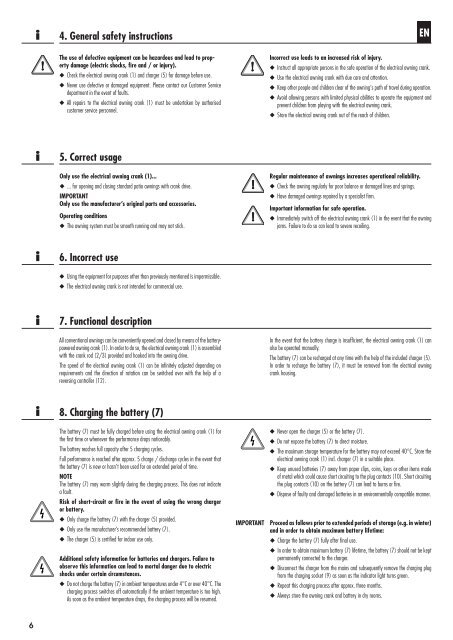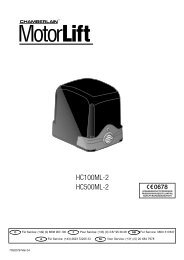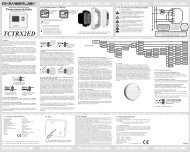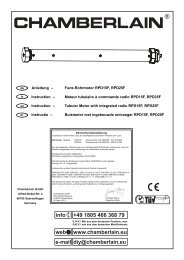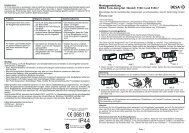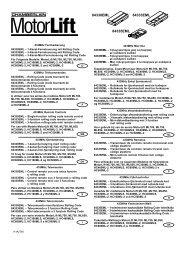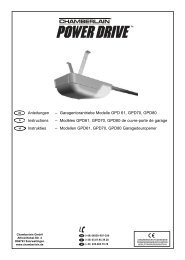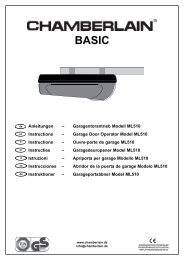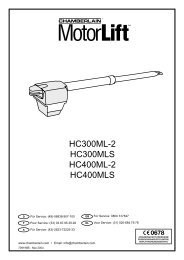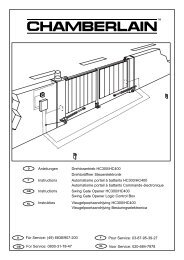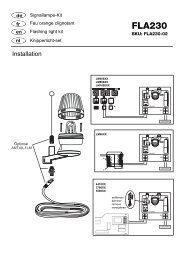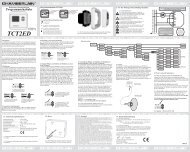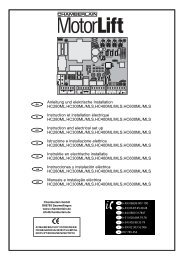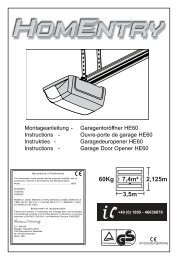Bedienungsanleitung Elektrische Markisenkurbel - 1DayFly.com
Bedienungsanleitung Elektrische Markisenkurbel - 1DayFly.com
Bedienungsanleitung Elektrische Markisenkurbel - 1DayFly.com
Create successful ePaper yourself
Turn your PDF publications into a flip-book with our unique Google optimized e-Paper software.
i<br />
4. General safety instructions<br />
EN<br />
The use of defective equipment can be hazardous and lead to property<br />
damage (electric shocks, fire and / or injury).<br />
◆◆<br />
Check the electrical awning crank (1) and charger (5) for damage before use.<br />
◆◆<br />
Never use defective or damaged equipment. Please contact our Customer Service<br />
department in the event of faults.<br />
◆◆<br />
All repairs to the electrical awning crank (1) must be undertaken by authorised<br />
customer service personnel.<br />
Incorrect use leads to an increased risk of injury.<br />
◆◆<br />
Instruct all appropriate persons in the safe operation of the electrical awning crank.<br />
◆◆<br />
Use the electrical awning crank with due care and attention.<br />
◆◆<br />
Keep other people and children clear of the awning‘s path of travel during operation.<br />
◆◆<br />
Avoid allowing persons with limited physical abilities to operate the equipment and<br />
prevent children from playing with the electrical awning crank.<br />
◆◆<br />
Store the electrical awning crank out of the reach of children.<br />
i<br />
5. Correct usage<br />
Only use the electrical awning crank (1)...<br />
◆ ◆ ... for opening and closing standard patio awnings with crank drive.<br />
Important<br />
Only use the manufacturer’s original parts and accessories.<br />
Operating conditions<br />
◆◆<br />
The awning system must be smooth running and may not stick.<br />
Regular maintenance of awnings increases operational reliability.<br />
◆◆<br />
Check the awning regularly for poor balance or damaged lines and springs.<br />
◆◆<br />
Have damaged awnings repaired by a specialist firm.<br />
Important information for safe operation.<br />
◆◆<br />
Immediately switch off the electrical awning crank (1) in the event that the awning<br />
jams. Failure to do so can lead to severe recoiling.<br />
i<br />
6. Incorrect use<br />
◆◆<br />
Using the equipment for purposes other than previously mentioned is impermissible.<br />
◆◆<br />
The electrical awning crank is not intended for <strong>com</strong>mercial use.<br />
i<br />
7. Functional description<br />
All conventional awnings can be conveniently opened and closed by means of the batterypowered<br />
awning crank (1). In order to do so, the electrical awning crank (1) is assembled<br />
with the crank rod (2/3) provided and hooked into the awning drive.<br />
The speed of the electrical awning crank (1) can be infinitely adjusted depending on<br />
requirements and the direction of rotation can be switched over with the help of a<br />
reversing controller (12).<br />
In the event that the battery charge is insufficient, the electrical awning crank (1) can<br />
also be operated manually.<br />
The battery (7) can be recharged at any time with the help of the included charger (5).<br />
In order to recharge the battery (7), it must be removed from the electrical awning<br />
crank housing.<br />
i<br />
8. Charging the battery (7)<br />
The battery (7) must be fully charged before using the electrical awning crank (1) for<br />
the first time or whenever the performance drops noticeably.<br />
The battery reaches full capacity after 5 charging cycles.<br />
Full performance is reached after approx. 5 charge / discharge cycles in the event that<br />
the battery (7) is new or hasn’t been used for an extended period of time.<br />
Note<br />
The battery (7) may warm slightly during the charging process. This does not indicate<br />
a fault.<br />
Risk of short-circuit or fire in the event of using the wrong charger<br />
or battery.<br />
◆◆<br />
Only charge the battery (7) with the charger (5) provided.<br />
◆◆<br />
Only use the manufacturer’s re<strong>com</strong>mended battery (7).<br />
◆◆<br />
The charger (5) is certified for indoor use only.<br />
Additional safety information for batteries and chargers. Failure to<br />
observe this information can lead to mortal danger due to electric<br />
shocks under certain circumstances.<br />
◆◆<br />
Do not charge the battery (7) in ambient temperatures under 4°C or over 40°C. The<br />
charging process switches off automatically if the ambient temperature is too high.<br />
As soon as the ambient temperature drops, the charging process will be resumed.<br />
IMPORTANT<br />
◆◆<br />
Never open the charger (5) or the battery (7).<br />
◆◆<br />
Do not expose the battery (7) to direct moisture.<br />
◆◆<br />
The maximum storage temperature for the battery may not exceed 40°C. Store the<br />
electrical awning crank (1) incl. charger (7) in a suitable place.<br />
◆◆<br />
Keep unused batteries (7) away from paper clips, coins, keys or other items made<br />
of metal which could cause short circuiting to the plug contacts (10). Short circuiting<br />
the plug contacts (10) on the battery (7) can lead to burns or fire.<br />
◆◆<br />
Dispose of faulty and damaged batteries in an environmentally <strong>com</strong>patible manner.<br />
Proceed as follows prior to extended periods of storage (e.g. in winter)<br />
and in order to obtain maximum battery lifetime:<br />
◆◆<br />
Charge the battery (7) fully after final use.<br />
◆◆<br />
In order to obtain maximum battery (7) lifetime, the battery (7) should not be kept<br />
permanently connected to the charger.<br />
◆◆<br />
Disconnect the charger from the mains and subsequently remove the charging plug<br />
from the charging socket (9) as soon as the indicator light turns green.<br />
◆◆<br />
Repeat this charging process after approx. three months.<br />
◆◆<br />
Always store the awning crank and battery in dry rooms.<br />
6


